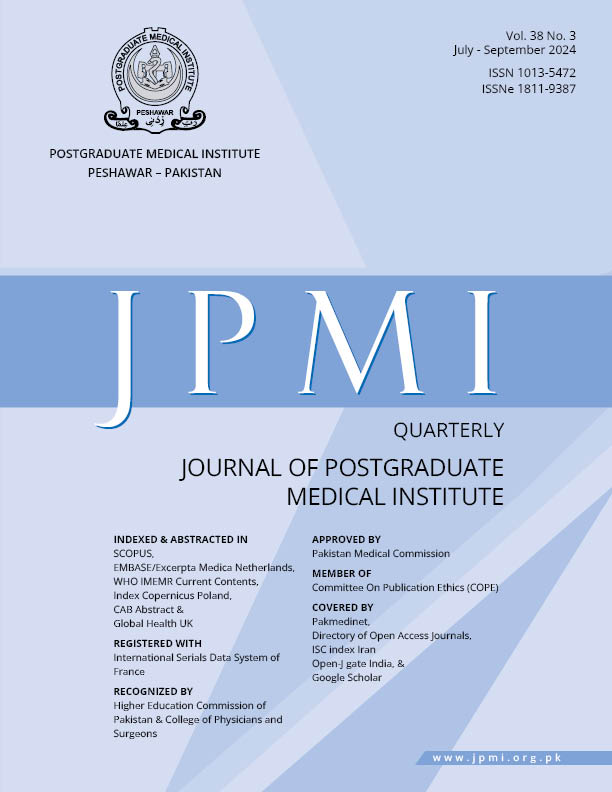Frequency and Risk Factors of Postoperative Hyponatremia in Primary Hip and Knee Arthroplasties Patients at a Tertiary Care Hospital, Karachi, Pakistan
Main Article Content
Abstract
Objective: To determine the frequency of hyponatremia and risk factors (age, comorbidities) and its impact on length of hospital stay in patients who underwent primary hip and knee replacement at a tertiary care hospital, Karachi, Pakistan.
Methodology: The present study was conducted at Department of orthopedics, Agha khan hospital with cross sectional study desing, from December 10, 2019 till June 10, 2020. Sample size was 189 and these were those patients undergoing hip and knee arthroplasty. Quantitative data were presented using mean and standard deviation, while qualitative variables were described using frequencies and percentages. SPSS version 21 was utilized for data analysis.
Results: The total number of study cases was 189 with mean age of 52.28±6.14 years. Out of 189 patients who underwent hip and knee arthroplasty, 84 (44.4%) had hyponatremia. Participants were divided in two Group A- who had the hyponatremia (n=84) and Group B- who had no hyponatremia (n=105). The mean± S.D of the age in both groups were 54.4±3.8 and 35.97±3.63 years (p=0.000). Participants with hyponatremia were predominantly females (73%, p=0.000). In both group participants with ASA grading 2 were abundant (67%vs56%: p=0.000). Mean± S.D of the length of stay in both groups were 6.6±1.4 and 2.85±0.94 days (p=0.000).
Conclusion: Our study revealed a significant 44% incidence of postoperative hyponatremia (POH) among hip and knee arthroplasty patients. Notably, advancing age correlated strongly with POH. Additionally, prolonged surgery duration was identified as a significant risk factor.
Article Details
Work published in JPMI is licensed under a
Creative Commons Attribution-NonCommercial 2.0 Generic License.
Authors are permitted and encouraged to post their work online (e.g., in institutional repositories or on their website) prior to and during the submission process, as it can lead to productive exchanges, as well as earlier and greater citation of published work.
References
Adrogué HJ, Madias NE. Hyponatremia. N Engl J Med. 2000;342(21): 1581-1589.
Clayton JA, Le Jeune IR, Hall IP. Severe hyponatraemia in medical inpatients: aetiology, assessment and outcome. QJM. 2006;99(8):505-511.
Chow KM, Szeto CC, Wong TY, Leung CB, Li PK. Risk factors for thiazide-induced hyponatraemia. QJM. 2003;96(12):911-917.
Lobo DN. Fluid, electrolytes, and nutrition: physiological and clinical aspects. Proc Nutr Soc. 2004;63(3):453-466.
Chappell D, Jacob M, Hofmann-Kiefer K, Conzen P, Rehm M. A rational approach to perioperative fluid management. Anesthesiology. 2008;109(4):723-740.
Hoorn EJ, Lindemans J, Zietse R. Development of severe hyponatraemia in hospitalized patients: treatment-related risk factors and inadequate management. Nephrol Dial Transplant. 2006;21(1):70-76.
Lane N, Allen K. Hyponatraemia after orthopaedic surgery. BMJ. 1999;318(7195):1363-1364.
Renneboog B, Musch W, Vandemergel X, Manto MU, Decaux G. Mild chronic hyponatremia is associated with falls, unsteadiness, and attention deficits. Am J Med. 2006;119(1):71.
DiIorio TM, Sharkey PF, Hewitt AM, Parvizi J. Antiemesis after total joint arthroplasty: does a single preoperative dose of aprepitant reduce nausea and vomiting? Clin Orthop. 2010;468(9):2405-2409.
Grattidge P. Nausea and vomiting after major arthroplasty with spinal anaesthesia including morphine: a randomised trial of subhypnotic propofol infusion as prophylaxis. Acta Anaesthesiol Scand. 1998;42(1):124-127.
Miyagawa Y, Ejiri M, Kuzuya T, Osada T, Ishiguro N, Yamada K. Methylprednisolone reduces postoperative nausea in total knee and hip arthroplasty. J Clin Pharm Ther. 2010;35(6):679-684.
Mannesse CK, Vondeling AM, van Marum RJ, van Solinge WW, Egberts TC, Jansen PA Prevalence of hyponatremia on geriatric wards compared to other settings over four decades: a systematic review. (2013) Ageing Res Rev 12(1):165–173.
Corona G, Giuliani C, Parenti G et al The economic burden of hyponatremia: systematic review and meta-analysis (2016) Am J Med 129(8):823–835.e4.
Rittenhouse KJ, To T, Rogers A et al Hyponatremia as a fall predictor in a geriatric trauma population. (2015) Injury 46(1):119– 123.
Tolouian R, Alhamad T, Farazmand M, Mulla ZD The correlation of hip fracture and hyponatremia in the elderly. (2012) J Nephrol 25(5):789–793.
Sah AP. Hyponatremia after primary hip and knee arthroplasty: incidence and associated risk factors. Am J Orthop (Belle Mead NJ) 2014 Apr;43(4):E69-73.
Mukartihal R, Puranik HG, Patil SS, Dhanasekaran SR, Menon VK. Electrolyte imbalance after total joint arthroplasty: risk factors and impact on length of hospital stay. Eur J Orthop Surg Traumatol. 2019 Oct;29(7):1467-72.
Wang LH, Xu DJ, Wei XJ, Chang HT, Xu GH. Electrolyte disorders and aging: risk factors for delirium in patients undergoing orthopedic surgeries. BMC Psychiatry. 2016 Nov 23;16(1):418.


